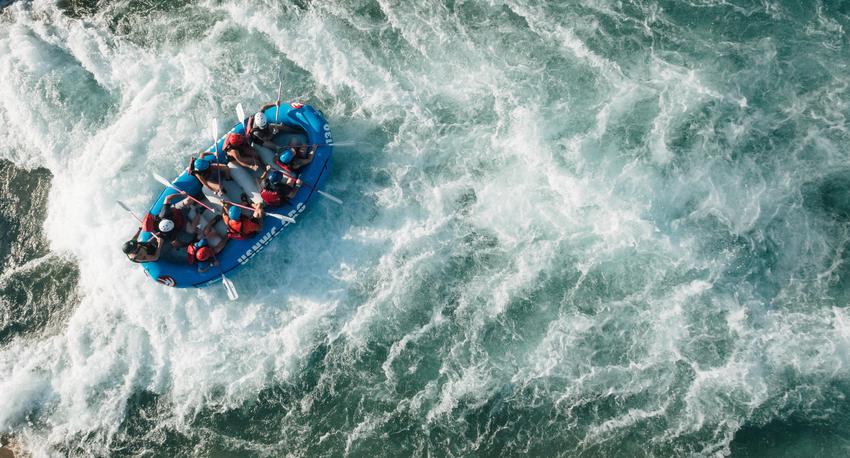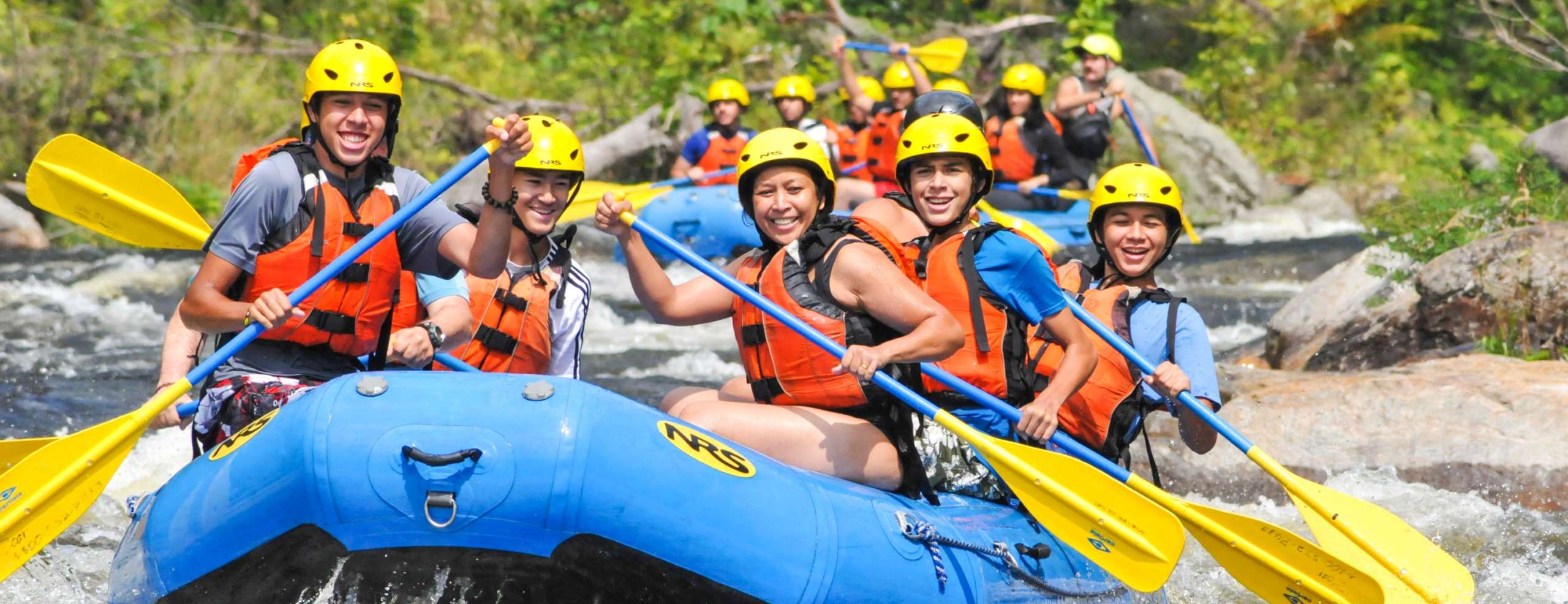Necessary Skills for Water Rafting
Mastering the art of water rafting calls for a combination of specific skills and expertise to navigate the uncertain currents of rivers, making it a thrilling yet potentially unsafe task. As lovers get ready to begin on their following adventure, it is critical to gear up oneself with crucial proficiencies that exceed simply paddling. From understanding the ins and outs of river dynamics to swiftwater rescue methods and smooth team communication, the trip down the river requires a blend of expertise and versatility. With safety and security procedures serving as a foundation, individuals are faced with a multifaceted difficulty that demands a meticulous method and steady emphasis.
Paddling Strategies
Grasping effective paddling techniques is essential for navigating water plethoras securely and efficiently. One fundamental strategy is the forward stroke, where paddlers dip the blade totally into the water and pull it back along with the boating to produce propulsion.
Aside from the forward stroke, the draw stroke is crucial for making fast adjustments or drawing the raft better to an object. By positioning the paddle blade vertical to the water's surface and drawing the water towards the plethora, paddlers can successfully change the vessel's instructions. Additionally, the backstroke works as a useful tool for supporting or reducing the plethora when needed.
River Reading
Reliable paddling techniques, such as the forward stroke and attract stroke, play an important duty in interpreting and browsing river currents, an ability understood as river analysis. River reading includes the capability to analyze the speed, deepness, and direction of the water circulation to make informed decisions while browsing rapids. By understanding exactly how the water moves challenges and via different channels, rafters can pick the very best path to securely traverse the river.
One secret facet of river analysis is recognizing different kinds of currents, including hydraulics, eddies, and waves, and comprehending just how they can influence the raft. Eddies, as an example, are locations where the water moves in a circular motion, commonly giving opportunities for remainder or critical maneuvers. Waves can indicate the presence of barriers or rocks, calling for fast adjustments in paddling technique. Hydraulics, typically called "openings," are locations where water recirculates back upstream, posturing possible hazards to rafts.
Mastering the ability of river analysis is crucial for secure and delightful rafting experiences, making it possible for paddlers to browse difficult waters with confidence and precision.

Swiftwater Rescue
Comprehending swiftwater rescue strategies is crucial for water rafting lovers to react successfully in emergency situation situations on fast-flowing rivers. Swiftwater rescue involves a set of specialized skills and expertise intended at securely removing individuals from swift-moving water. One key element of swiftwater rescue is recognizing the risks present in fast-flowing rivers, such as strainers, undercut rocks, and strong currents, to prepare and carry out effective rescue procedures.
Correct tools is essential for swiftwater rescue, including throw bags, rescue ropes, helmets, and personal flotation protection tools. Rafting fanatics have to be adept at utilizing this tools in high-stress scenarios to make certain the safety and security of themselves and others. In addition, swiftwater rescue strategies usually entail team effort and sychronisation among rafters to perform complex rescue maneuvers effectively.
Educating in swiftwater rescue is very advised for individuals engaging in water rafting activities, as it outfits them with the needed skills to deal with emergencies promptly and successfully. White Water Rafting Colorado. By practicing and recognizing swiftwater rescue methods, water rafting enthusiasts can enhance their safety and security and that of their fellow rafters on challenging river explorations
Group Communication
Reliable team effort in water rafting relies greatly on seamless communication amongst employee to make certain collaborated and safe navigating through tough river conditions. Succinct and clear communication is crucial for the success of any kind of rafting expedition. Staff member have more helpful hints to have the ability to effectively share essential details such as paddling commands, warning signals, and navigational instructions.
In the hectic and frequently uncertain setting of river rafting, timely and exact communication can indicate the distinction in between a successful run and a possible catastrophe - White Water Rafting Colorado. Each employee plays an important role in the total communication procedure, whether it be paying attention attentively to the guide's guidelines, relaying info to various other paddlers, or signaling for assistance when needed
Developing a common language and communication system before striking the water is essential. This makes sure that every person is on the same page and recognizes just how to communicate efficiently throughout the rafting trip. By promoting a society of open interaction and common respect, rafting teams can improve their performance and security on the river.

Safety Procedures
In the context of water rafting, the foundation of group communication developed throughout expeditions is more reinforced via stringent adherence to safety and security protocols. Security methods are critical in ensuring the wellness of both rafters and overviews during water rafting expeditions. One vital security method is the proper using of individual check over here flotation gadgets (PFDs) by every person on the plethora. PFDs are essential in emergency situations to maintain participants afloat and offer buoyancy. Furthermore, rafters have to be well-versed in swiftwater rescue methods and methods in instance of someone falling too far or if the plethora tips over.
Another secret safety and security method is the thorough briefing provided by guides before embarking on a rafting trip. This briefing generally includes information on paddling techniques, what to do in case of various website link emergency situations, and signals made use of for interaction throughout the trip. It is vital to have designated safety and security kayakers coming with the team to offer immediate assistance if required. By strictly adhering to these safety methods, water rafting adventures can be both safe and thrilling for all individuals entailed.
Conclusion
Finally, understanding vital skills for water rafting is vital for a risk-free and delightful experience on the river. Paddling strategies, river reading, swiftwater rescue, group communication, and safety and security procedures are all crucial elements that add to a successful rafting journey. By developing these abilities, rafters can navigate difficult waters with self-confidence and guarantee the safety and security of themselves and their team participants.
Mastering the art of water rafting calls for a combination of exact skills and understanding to browse the unpredictable currents of rivers, making it a thrilling yet potentially unsafe activity. By putting the paddle blade perpendicular to the water's surface and drawing the water towards the boating, paddlers can successfully alter the vessel's direction.Understanding swiftwater rescue methods is critical for water rafting fanatics to respond successfully in emergency situation situations on fast-flowing rivers.Efficient team effort in water rafting counts heavily on seamless communication among group participants to make certain coordinated and risk-free navigation with challenging river conditions.In final thought, understanding essential skills for water rafting is important for a satisfying and secure experience on the river.